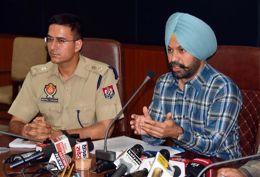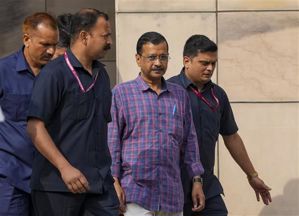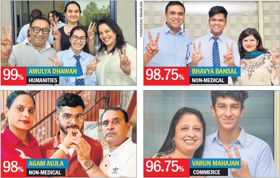
Tribune News Service
A typical scene at your home or office as someone works on his mobile phone: ‘Can you speak louder…can’t hear… shift to another room, your voice is broken.’ Or, in between a mobile conversation, just as you are conveying the most important thing, you realize, the receiver has hung up. Then you call again, only to find out that the previous call had ‘dropped.’ Result: both sides end up paying for the calls.
The second common scene is you are making an online payment at a shop, the net speed is so slow that the shopkeeper asks you to either pay in cash or come back when you hit the right net speed.
“Ridiculous,” is the politest way to describe the disgust.
What do you do? Pride yourself being among the billion-plus cellphone subscribers -- a cog in the giant wheel of the second largest smartphone market? The frustrating reality is you’d go nowhere. So go grin and bear with it as the Modi government pushes and patronizes the digitization dream to its extreme. All that comes riding back on two latest ‘smart’ reports: Reliance Jio claimed exponential rise in its subscriber base (7 crore) following its gratis offer of free voice and data services 170 days ago. In these days Jio subscribers consumed 100 crore GB (gigabyte) data. Jio will now go the tariff way starting April 1.
The second is: Bharti Airtel, India’s largest telecom service provider, will acquire Norwegian telecom operator Telenor’s India operations to hold onto its number one position in terms of revenue as well as subscriber space in the market. Consolidation is now the name of the game. But where do you fit in?
Call drops
First the call drops. The government late last year launched an Integrated Voice Response System (IVRS) at multiple locations including Delhi and Mumbai to obtain direct feedback from subscribers on call quality. The feedback will be shared with operators so they can take corrective steps in the problem areas and address call drops. The subscribers will receive an IVRS call from the short code 1955 and will be asked a questions such as whether they are facing or not (facing) call drops in their area.
“They can also send a toll-free SMS to the same short code 1955, containing the location of city/town/village, where they might be facing the problem of frequent call drops,” it added. Commenting on the initiative, communications minister Manoj Sinha said, “The platform is a channel to capture direct feedback from the consumers and this voice of the customer can be used to improve services that are being offered to them.” Result: it’s work in progress.
As for slow net connectivity, simply blame the clogging of the spectrum space that a service provider offers you. Or sit tight, until good sense prevails among the Telecom Regulatory Authority of India (TRAI), the service providers and maybe courts over an opaque tariff and data usage packages.
Downgraded
That perhaps would have weighed in on India Ratings and Research agency to downgrade the outlook of the India’s telecom sector from ‘stable’ to ‘negative’ for the current fiscal year. The rating agency said that the entry of Mukesh Ambani-controlled Reliance Ji (RJio) would lead to intense competition as the operator would be hunting down subscribers and the market share out of the existing mass being serviced by incumbent operators. As a result, data market will be first to face the impact of increasing competition, leading to a decline in data average revenue per user.
In India, the increasing number of broadband users and wireless subscribers (see info box) does not really reflect the correct picture of the country’s telecom market, the fastest growing mart in the world.
Not a rosy picture
Experts point out that over the past two decades, telecom companies have been busy building infrastructure critical to the communications sector. But despite all the effort put in to build the networks the industry has seen minimal growth of just 0-3% in the past few years, while sectors that use their networks -- internet services – have seen a growth rate at least six times higher, which is putting intense pressure on the networks and operators.
Ever since the BJP-led NDA government has taken over, Prime Minister Narendra Modi has been pushing for a digital economy and less cash economy. But the lack of infrastructure coupled with the basic problems of the Indian rural scenario has proved to be a major impediment. The most basic aspect remains the connectivity, where the operators have been greatly lacking. Call drops remain the biggest issue whether it is in urban India or rural.
Call drops have become the undoing of several booming sectors, including India’s mobile-powered e-commerce industry, where frequent call drops make consumers nervous about payments. And in villages and towns, people net accessibility is solely through mobile phones. While call drops now figure among the top customer issues with telcos, there is very little transparency on call drop data and it can be said that most telecom companies have multiple sites where the call drop incidence is much above the stipulated 2% ceiling.
What operators say
Telecom firms, however, argue they have to make do with very little spectrum, which they point out is about a fifth of the spectrum compared with their counterparts in other countries. Operators also have an unfair advantage with dropped calls from per-minute users as callers end up paying for an entire minute if a call drops in between, especially within the first few seconds.
The operators seek to dismiss the claims. The prime reasons for dropped calls are inadequate coverage which can be due to multiple reasons. One is tower infrastructure, bad network planning, non-optimization of network, overloaded cell towers, changes in cityscape, switching between towers and technical failures. A report brought out by Ernst and Young has said that India has the dubious distinction of having one of the lowest Point of Sale terminal penetration, with only 693 machines per million.
On the other hand Brazil had 32,995 terminals per million people and China and Russia had around 4,000 terminals per million people.
Inputs by Girja Shankar Kaura



























